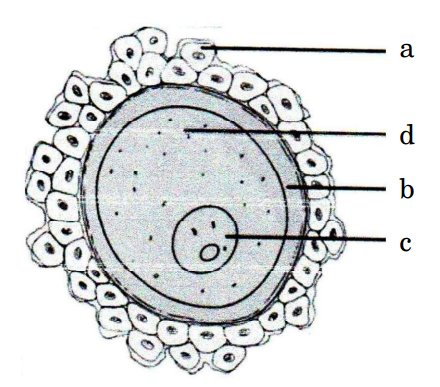Question
(a) Given below is a diagrammatic representation of a human ovum.
i) Identify the parts 'a', 'b' and 'c'.
ii) This ovum is released from the ovary with incomplete meiotic division. When, where and how is the meiotic division completed ?
iii) How does an ovum ensure the entry of a single sperm during fertilization ?
or
(b)
i) Double fertilization is an event unique to all flowering plants. Explain the process.
ii) Give a reason for the following :
1. A seed of an orange has many embryos.
2. Cashew is a false fruit but Guava is a true fruit.
Answer :
(a)
i) a- Cells of corona radiata. b- Zona pellucida /Perivitelline space c- Haploid nucleus
ii)
• Once the sperm enters the cytoplasm of the ovum
• The whole process is completed within the fallopian tube.
• Entry of sperm in the cytoplasm of the ovum induces the completion of the 2nd meiotic division of the secondary oocyte, it is unequal division and results in formation of a second polar body and a haploid ovum(ootid).
iii) During fertilization as the sperm comes in contact with the zona pellucida layer of the ovum, it induces changes in the membrane, that block the entry of any additional sperms.
or
(b)
i)
• Double fertilisation is the occurrence of two types of fusion syngamy and triple fusion in an embryo sac of the angiosperm. • Syngamy- Fusion of one of the male gamete and the egg cell resulting in formation of a zygote (diploid).
• Triple fusion - Fusion of another male gamete with two haploid polar nuclei to produce a (triploid) primary endosperm nucleus. ii)
1. Some of the nucellar cells surrounding the embryo start dividing and protrude into the embryo sac to form embryos.
2. In case of Cashew thalamus also contribute in fruit formation along with ovary /development of fruit after fertilization from the part other than ovary, Guava fruit develops from the ovary after fertilization.

